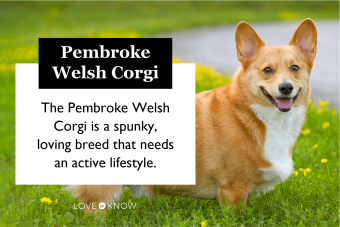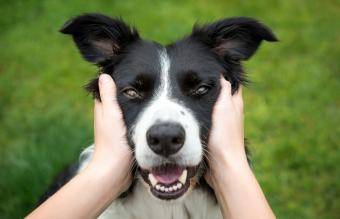
The Pembroke Welsh Corgi is a spunky, affectionate, small dog breed. They were once popular as herding dogs, but are becoming significantly more popular as companions.
Origins and History

Corgis were classified as purebred dogs by the UK Kennel Club in the 1920s. When they were originally shown in 1925, they were given the name Welsh Corgis. Pembrokes and Cardigans were presented together in the same class at the time.
The Kennel Club finally recognized the Pembroke and Cardigan as two distinct breeds in 1934. The American Kennel Club followed suit in the same year. Pembrokes made their debut in the United States in 1936.
Pembrokes have steadily grown in popularity in the United States, and they are now in the top 50 most popular family pet breeds. Their popularity is often said to be due to Queen Elizabeth II of England, who acquired her first Pembroke Welsh Corgi in 1933 from her father, King George VI, and hasn't been without one since.
Notable Breed Types
The Pembroke Welsh Corgi is often confused with the Cardigan Welsh Corgi, although they have been distinctly separate since the 1800s. Pembrokes named after their place of origin, Pembrokeshire, whereas Cardigans are from Cardiganshire. The primary differences between the two breeds are apparent in their ears and tail. Most Pembroke Welsh Corgis don't have a tail, whereas the Cardigan does. The ears of the Pembroke are also pointed and erect, whereas the Cardigan's are rounded.
Characteristics of the Breed

Pembrokes are known for their fox-like facial appearance, short legs, and long body.
Appearance
The Pembroke Welsh corgi was supposedly given to humans by the fairies, who used corgis to draw their carriages and ride into battle, according to folklore. This is why a darker patch of fur on certain corgis' shoulders is referred to as a "fairy saddle." Coat colors include:
- Red
- Sable
- Black
- Fawn
- Tri-color
The coat's length varies with each unique dog. Some pembrokes have long, fluffy coats with a lot of feathering on their ears, chests, legs, and paws, whereas others have less.Pembroke Welsh Corgis stand 10 to 12 inches tall at the shoulders and average approximately 30 pounds.
Temperament
Pembrokes are still employed as working dogs, but they are now more commonly seen as companions. They are recognized for being cheerful, loving, and intellectual, yet they can also be stubborn or independent, which is common with smart dog breeds. Although they are generally easy to train, don't expect your Pembroke to be obedient. They enjoy being able to think for themselves.
Pembrokes are also excellent watchdogs. Strangers can make them wary, and they will bark if they believe something or someone is threatening their house and family.
They were developed to herd cattle while also being gentle enough to aid farmers' children in the courtyard. As a result, pembrokes have a special love for children, although their herding tendencies cause them to nibble at their feet or ankles. Fortunately, they are quick learners and may be trained out of this habit at a young age.
Corgis should not be left alone for long periods of time. They were raised as herding dogs, so they are accustomed to being in the company of other animals and people. If you need to leave the house, ask a friend if they can look after your dog. Dogs, like humans, can become lonely and depressed when left alone.
Exercise Requirements

The Pembroke is happiest with a job to do. As a herding breed, that is typically expected. They do well with moderate levels of exercise and enjoy long walks. It's important to be mindful of their short legs and watch for when they are getting tired. If you want to engage your Pembroke even further, they often enjoy advanced obedience training, tracking, and agility.
The Pembroke is an energetic breed who thrives in a home with a fenced yard. If you live in a city apartment, your corgi will require daily exercise to be physically and mentally fit. Like most breeds, bored dogs will acquire undesired tendencies.
Training
The Pembroke can be resistant during training and require more time to master it than many other breeds. They understand what you're asking, but they're also stubborn. They are more likely to obey when they want to, rather than when you want them to. Food is a fantastic motivator for them when training, although praise is also a necessary addition to training, as well. Pembrokes are voracious eaters who can easily grow obese if their diet isn't controlled. Be mindful of how many treats you are providing.
The Pembroke, like all dogs, requires early socialization. It's most beneficial when they're young. They should be exposed to a wide range of people, animals, sights, noises, and experiences. Socialization is important for your puppy's development and to assist them in becoming a well-rounded adult dog.
Health Concerns
The Pembroke is generally healthy, but can be prone to various conditions:
- Hip dysplasia: A genetic condition where the hip joint does not fit properly into the thigh bone; often referred to the ball and joint. Some dogs demonstrate pain and lameness on one or both rear legs, while others show no signs of distress.
- Degenerative myelopathy: A degenerative condition that affects the nervous system. This condition may result in lameness and eventual paralysis.
- Von Willebrand's disease: A blood disorder that affects the clotting process. Symptoms include bleeding gums, nosebleeds, prolonged bleeding during heat, and blood in the stool.
- Retinal dysplasia: Abnormal development of the retina where the retina may detach. Blindness may occur.
- Intervertebral disk disease: Pembrokes have long backs that are prone to result in rupture of the spinal disk. Symptoms may include difficulty going up and down the stairs or into the car, weakness, unsteadiness, or paralysis.
- Epilepsy: An often-genetic neurological condition that causes mild to severe seizures.
Lifespan
The Pembroke Welsh Corgi has an average lifespan of about 11 to 13 years. Some members of the breed are longer-lived, especially with high-quality veterinary care, proper diet, and adequate exercise.
Grooming
Pembrokes have a double coat. The undercoat is thick with a long topcoat. They shed continuously, so expect to brush them on a daily basis.
Bathe your Corgi no more than once a month, unless conditions require a more frequent cleaning. This helps avoid stripping the coat of its natural oils. Trim your dog's nails regularly, roughly every three to four weeks.
Fun Facts about the Pembroke Welsh Corgi
The Pembroke has many admirable traits, characteristics, and an interesting history. The following are some fun facts about the breed:
- Pembroke's ancestors are thought to trace back to at least the 10th century. It's unclear if they're related to the Swedish Vallhunds or to the ancestors of today's Schipperkes and Pomeranians.
- They're prone to the "zoomies" and may exhaust themselves on occasion with their excitement.
- Rufus, a Pembroke, belonged to the editor-in-chief in the early days of Amazon. Rufus became the Amazon's unofficial mascot. He is the dog who is responsible for Amazon's dog-friendly culture.
Buying or Adopting a Member of the Breed

Pembrokes are frequently bought without a thorough grasp of what it takes to own one. Many Pembrokes are available for purchase through a breeder or via adoption. If you decide to look for a puppy through a breeder, be certain to evaluate the breeder properly to ensure the puppy has been well-cared for and socialized.
Purchasing from a Breeder
If you're looking for a Pembroke Welsh Corgi puppy, a good place to start is the Pembroke Welsh Corgi Club of America (PWCCA). They have a directory of breeders available, in addition to a list of tips helpful in locating reputable breeders. The AKC Puppy Finder also offers a breeder search to assist you in finding the right puppy. Expect to pay between $1,000 to $2,500.
Adopting from a Rescue
If you prefer to rescue a Pembroke, you can begin by searching Petfinder or Save-a-Rescue. You can also contact the following breed-specific rescue groups:
- Sunshine Corgi Rescue: A non-profit organization spanning the state of Florida.
- Southeast Corgi Rescue: A non-profit that adopts to the states of Georgia, North Carolina, and South Carolina.
- Columbia River Pembroke Welsh Corgi Club: Offers rescued Pembrokes and places them for adoption with dog lovers in the states of Oregon, Vancouver, and Washington.
- Pembroke Welsh Corgi Club of the Potomac: Typically has dogs that are 5 years old and older, and who are available for adoption in Pennsylvania.
Is this the Right Breed for You?
The Pembroke may be the right dog for you if you are an active person who doesn't mind taking a long walk every day and are willing to train a dog with a stubborn streak. If you live a more sedentary lifestyle, you might want to look for a less active dog. This breed can be a wonderful addition to your household if given enough activity and attention.







